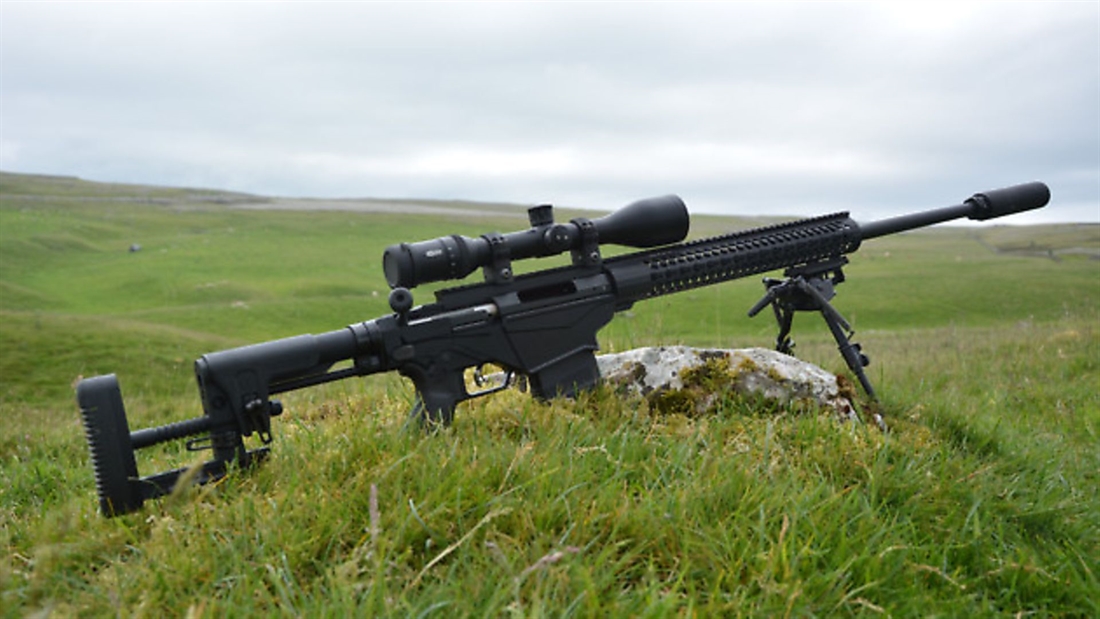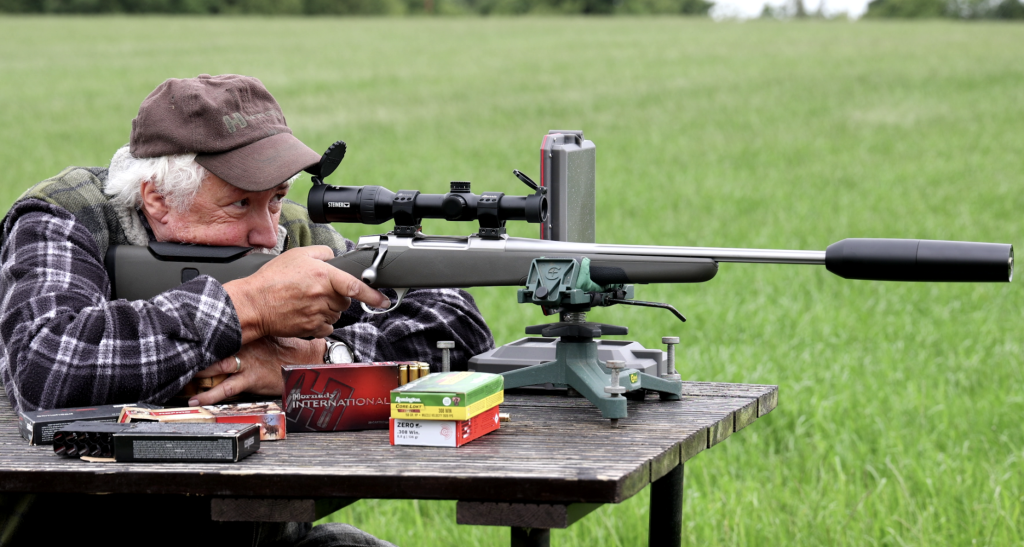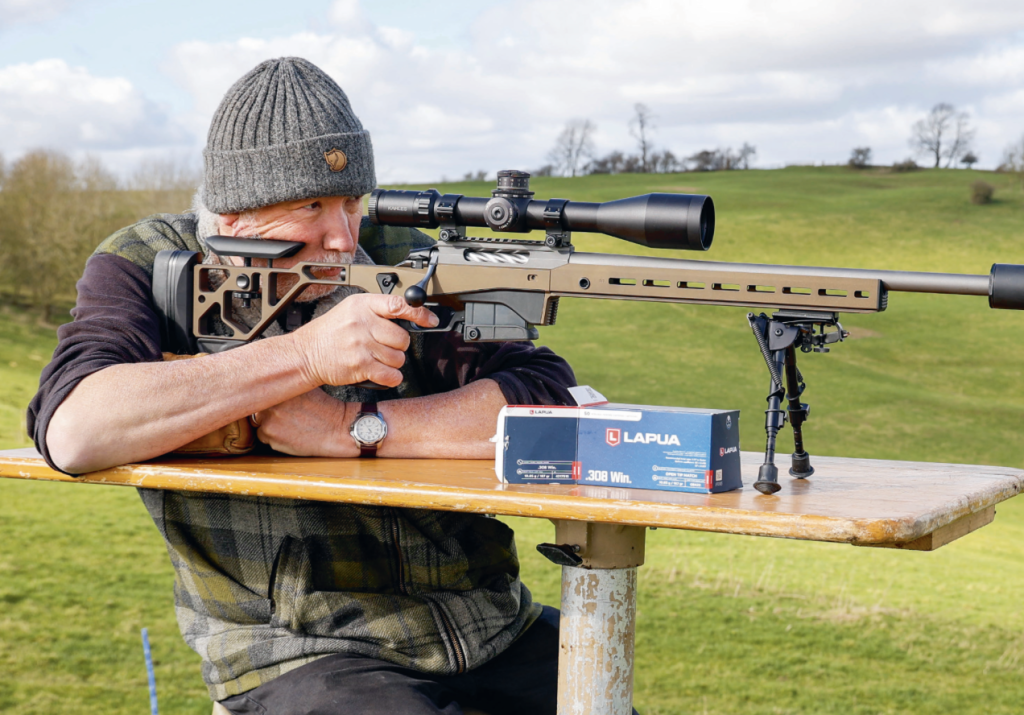Ruger Precision Rifle in .243 Winchester – in depth rifle review

Chris Parkin puts Ruger’s Precision Rifle through its paces on the range to find out whether the hype is justified
Likes:
Nothing really stands out because everything was done rather well
Dislikes:
The cheekpiece is quite bulky and needs high scope mounts regardless
AR-15 ergonomics always leave short reach to the trigger
Verdict:
I’m not one to believe the hype, and no gun has come along within my time in this game with quite as much fanfare as this one, but I must admit I thought it deserved everything said about it. It really is a fantastic rifle package with no stone left unturned and no accessories required. Just add a scope.
Thanks to:
01423 780810
Also used:
Meopta, B&T moderator, Lapua ammunition and brass
www.vikingarms.com
01423 780810
Berger Bullets
www.hannamsreloading.com
01977 681639
Lee Reloading Dies and Sierra Bullets
Henry Krank & Co
01132 569163
Winchester ammunition, BWM Arms
www.browning-int.com
01235 514550
Hornady Ammunition
www.edgarbrothers.com
01625 613177
Minox ZP5 scope
Blaser Sporting Limited
020 7622 2116
Tier-One Unimount
www.tier-one.eu
01924 404312
Specifications:
Overall length: 44.25-47.75”/1124-1213mm
Weight: 11lbs/5kg
Magazine capacity: 10+1
Trigger: Single stage, blade safety with 3-5lb pull range
Barrel length: 26”/660mm
Twist rate: 1-in-7.5” suitable up to 108gr bullets
Stock: AR-15 compatible folding stock
Scope mounting: 20 M.O.A. full length picatinny rail
Accessories: Two P-Mags supplied, picatinny rail mount for bipod
Recommended retail price: £1,400
Ruger’s Precision Rifles appeared like a tsunami and washed away everything in their path. They appeared all over social media and YouTube via users in the US, but it was quite some time before we saw them over here and, when they did arrive, they sold out as soon as they passed proof.
I am always cautious of believing the hype but it took nearly a year for my test gun to become available. The first one I saw was the seemingly most favourable 6.5 Creedmoor. Available in good ol’ .308, the most likely candidate for those wishing to avoid ammunition shortages, I was intrigued to see .243 on offer.
All three calibres differ in barrel length, but the 26” I have on test is perhaps the most appropriate for target use, if not perhaps in .243. A .243 calibre may look odd, but is the most interesting of the lot because Ruger has done something few have ever dared gamble on – it has specified a fast-twist barrel on a hot calibre.
The .243 Winchester calibre is one that can be very picky about ammunition. This is due to many standard sporting rifles being specified with a 1 in 10” twist barrel, which, in all honesty, is true to the original design ethic of the cartridge, aimed at lighter varmint bullets. With UK and specifically Scottish shooters requiring heavier rounds, yet remaining within the 0.240” calibre requirement, bullets became longer and got a little twitchy at the 90-105gr point. This is where stability from the rifling becomes critical.
Bullets like the 105gr soft-point GECO seem to perform despicably well because the physical length of the bullet, rather than the actual weight, is kept to a minimum. Yet in these days of long range and ballistic coefficients being ever extended, it wasn’t hard to find that some polymer-tipped bullets (physically longer) would not shoot well. Personally, for sporting .243 use, I’d rather have seen a 9” twist adopted as the norm, but that’s just my opinion… it would likely harm .243 ammunition sales as less experimentation would be required.
So anyway, Ruger has gone with a 1 in 7.5” twist rate on this barrel and for a good reason: where the 6.5mm are mid-sized kings of recoil and ballistics, with a bit of careful reloading the 6mm cartridges can virtually mimic the ballistics of the 6.5, with a fraction less recoil. For all the song and dance made about 6.5s, you really are into reloading territory, and shortages of ammo and brass have affected the wonderfully specified Creedmoor.
Yet this .243 will shoot any old ammo and, although you might find lighter, faster 55/58gr varmint bullets will explode in flight if driven too hard, you can happily venture into the realms of 105/6/8 bullets with BCs in the 0.5s, providing some serious long-range action with cheap brass and dies. And more choice! The 7.5” twist is not rated to handle the legendary 115 DTAC bullet so popular in competitive US tactical matches, but it might be worth a try… you never know.
Anyway, the Ruger Precision Rifle (RPR) has a medium-contour hammer-forged barrel, tapering from the action to 0.75” at the 5/8” x 24 threaded muzzle for a brake or mod. It has 5R rifling that claims some benefits over conventional grooves, but like everything to do with barrels and their individual unique nature, who really knows if it is better or not? Ruger promises tight tolerances on the head-space, and I have no reason to doubt this, alongside other tolerances and machining standards shown across the whole of the fully integrated rifle build.
The action is all steel and follows the ergonomic patterns laid down by the AR-15, with underslung grip and upper/lower receiver sections (the upper is basically a Ruger American action). The long tubular Samson fore-end shows intricate machining to maximise stiffness with minimum weight, while aiding airflow for cooling around the barrel. A 20 MOA rail runs the full length of the gun for all your optical needs, and extra sections of Picatinny can be added for further customisation. Most importantly, a 3” section is supplied with fittings to mount a bipod underneath the tip, either using a stud, such as a Harris, or direct to the Picatinny, like an Atlas will.
Bolt lift and cycling all happen from a 70-degree lift to unlock the three lugs. Machining and shape on the bolt shaft is the most complex I have seen, and I assume it is to do with compatibility with multiple magazine types; the function was faultless with positive feed and plentiful ejection through the minimal port. Primary extraction and re-cocking of the bolt were well timed and slick, which is noticeable on a heavy, stable rifle like this that will, nine times out of 10, be shot fully supported (probably prone).
Lifting the bolt’s polymer teardrop handle was comfortable and didn’t disturb the point of aim. Two 10-round twin column P-Mags are supplied, but AICS magazines (as well as M110/SR-25/DPMS and Magpul) are compatible with the cleverly designed mag well on the action’s ‘lower’, to compensate for differing dimensions and locking mechanisms. The P-Mags give you a ‘last round’ interruption/hold open to the bolt cycle, although if you push hard it will still skip over the top of the follower to close the gun for transport.
Mag release is a two-stage push lever (depending on mag type/release mechanism requirements) to the front of the trigger guard, surrounding the Ruger Marksman Adjustable trigger blade with inner safety lever. It was nothing magical – these are fairly common now and it gave a good feel to the shot release, not ultra-crisp but always predictable with good feel and no grittiness. Mine broke at 1,100g/2.5lbs, which I found pleasant to use.
The safety lever sits to the left (it can be reversed) of the receiver/grip and so is operable with the firing hand thumb in situ, but the reach to the trigger blade from the AR-15 grip/ergonomics is a little short for those not used to the characteristic feel of such guns. It’s perfectly usable but, if you aren’t careful, migrates into the first knuckle joint of the index finger, rather than the mid-pad. This does have an opposing benefit: if you do keep it mid-pad it ensures you have a good trigger squeeze and control in a straight line without undue lateral pressure, but lazy shooters who wrap all the way through will notice the snatch if they’re not careful. The trigger adjusts externally from 2¼ up to 5lbs, which is handy for certain competition rule books, although I would always ‘practise as you mean to compete’, and get that done well ahead of time.
The latest versions of the gun will have an aluminium bolt shroud and muzzle brake supplied, but I can’t really see a need for the first, unless you are prone to dropping the bolt in cold climates. The latter is nice, but I’m a serious moderator lover these days, and the US is becoming so too. A brake is really no great cost addition, but I get fed up of the noise, which is worse than the gun being ‘naked’. My RPR was supplied with a superb end-of-barrel Brugger & Thomet moderator. Recoil-wise, .243s aren’t exactly pokey, but hearing damage is cumulative, so better safe than sorry when you shoot as much as I do.
With scope and bipod fitted, there was little to do except have a play about with the adjustable stock/chassis for ultimate comfort. The butt is compatible with AR-15 designs, although the supplied unit lacks little in terms of creature comforts. Being an in-line build, recoil is transferred straight through the gun, minimising muzzle lift, but the effective vertical height of the gun does increase. The cheekpiece is adjustable for height but not for lateral position and, to wrap over the tubular structure, needs to be quite rounded and felt a bit bulky to me – I hate having to ‘roll my head over’ to get the cheek weld we aspire to, I like to keep my eyes horizontal.
Scope height above the bore is already quite high, with a good 20-25mm effective clearance from the actual barrel to the scope (disregarding the encompassing tubular fore-end), yet I would add even higher mounts than required, just to lift my head, which is something I only ever find on bullpups and full chassis guns like this. Two locking levers adjust the height and length of pull, with all secured solidly for use, just like the 100% ‘clunk’ you get from the hinge that allows the gun to fold – all well executed. You need to fold the gun to remove the bolt, and it has a neat rotating catch to lock it when folded so you won’t trap your fingers, as it can’t swing shut. More Picatinny rail resides below the buttpad for the possible addition of a monopod or, more likely, to support the gun on a rear bag or gripped fist. Yet more neat little touches. Ruger supplies a polymer Picatinny rail infill/cover, so the sharp edges of the anodised aluminium don’t dig into your hand. Picatinny rail is designed like that – it’s very grippy, but it will cut you, so well done Ruger!
I shot the gun using various factory ammo, and had some very impressive results out to 400 yards with plain 90gr Lapua FMJ that developed 3,090fps (942m/s), which was higher than expected, going to show that the 26” tube was really delivering the goods. Out of interest, I also shot Winchester, PPU and Hornady soft-point hunting ammunition in the 90-100gr range, and all worked perfectly well with sub-MOA accuracy on paper, again close to their stated velocities too.
This gun just had to be hand-loaded, though; it would be such a shame to waste the opportunity, so all that Lapua brass was reloaded, paired with CCI BR2 primers and IMR 4350 powder to ladder test a couple of likely loads. First, I tried 108gr Berger HPBT (non VLD) rounds loaded to SAAMI spec COL, although the magazine size would happily allow greater experimentation with seating depth at a later date. Initial trials soon had me running at 2,850fps for great long-range supersonic potential, but more experimentation and perhaps a slightly slower powder would have improved accuracy and velocity even further from the ¾ MOA groups I quickly found.
The 107gr Sierra Matchkings were next up, and these immediately suited the barrel with some decidedly petite groups in the ¼ to ½” zone at similar velocities. This gun is designed to complement the new shooter as well as serious hand-loaders and experienced shots, so although I could have experimented to the ends of the earth, initial findings showed immediate potential, and keeping it simple is my preferred option for nearly all the rifles I hand-load for. This result really suits someone getting into the sport with little temperamental hassle.
I find reloading a little like motor racing – the closer you run to the edge chasing perfection and accuracy, the nearer you are to slipping over it. Safety is a primary factor, of course, but I also feel that some very temperamental loads that are hard to make work may be easy to find lacking, if tiny, conditional requirements, tolerances and variables are exceeded.
Given that actually going shooting and using this ammo does have a life-long effect on your barrel, I was keen to see that the Ruger can be easily stripped using armourer’s tools, and the barrels replaced. Yes, folks, barrels are consumables, and when it comes to target use, it’s a factor one must incorporate into the long-term plan… so, another thumbs up for Ruger. Let’s just hope some are actually available from stock.
The barrel here has a smooth Parkerised finish and did tend to mark quite easily, but this added nothing but character to a gun that will never be a cabinet queen. All QR toggles on the stock are adjustable for exact tension, from finger-flip-tight to virtually locked solid, and so are easily adapted to long-term solidity or speedy fingertip positional variation to suit various shooting formats and courses of fire. All aluminium is hard anodised and, although mechanically durable, also shows a bit of wear and tear, but this can be likened to the patina of character in a fine shotgun – it shows a lifetime of actual use.
I have shot the short-barrelled 20” version of the gun and, recoil-wise, this is totally opposite to the .243. Both have very well-controlled manners with almost zero muzzle shift, and allow you to track the bullet trace on longer shots all the way into target. Of course 6mm, like 6.5mm bullets, are correspondingly slippery through the air, but I find myself missing the more obvious trace of the less efficient 30 cals on occasions when ‘lost’ bullets are more easily spotted and called into a target in the wind.
It is a shame that Ruger hasn’t offered a 24” .308 option, as this rifle would still be my favourite in the UK, but market research in the gun world does indicate that, for competitive multi-position shooting in the US’s massive home market, a short, un-moderated .308 is a far more versatile everyday gun; even the Creedmoor is a less suitable option, especially if standing unsupported. The long fore-end and rearward balance of this gun just scream ‘prone or bench-only’ to me.
For those firing large volumes of ammo, .308 is still the choice, with a like-for-like barrel life probably double that of the two smaller, relatively overbore calibres. I put about 150 rounds through the Ruger and it felt like everything was wearing in nicely. The mag well was becoming faster as the mag and anodising polished their skins with use. I actually preferred the P-Mags as you can load them from the top and they are more compact.
I didn’t strip the gun but, with a full complement of Allen key slots about the structure, all seems logical and straightforward; just be careful when locating the fore-end Picatinny mount, as it requires precise location within the keyholes to make sure it won’t slip out. Viking supplied a Meopta scope with the rifle to get me going, but for longer range shooting I switched to a Minox, which is more capable of fast long-range dialling in a Tier-One unimount, and this brought the gun to life as it was better suited to fast corrections at range, on a rifle that was a joy to shoot all day.
Recoil brings no joy to anyone, and this .243 is an ideal choice for the keen shooter who wants a complete gun package, with no shortcuts or voids in the process; it really is a scope-up-and-go rifle with any factory ammo, so I can easily see why it has been such a sensation. I wish rifles like this had been available to me 10 years ago, instead of having to virtually build one from parts begged and borrowed.
This gun has been available before, but never at such good value, and I would have to say that it fits into a very small group of products I have reviewed that really are stunning value for money and show that the manufacturer has been led and advised by shooters, not accountants, with a thorough understanding of what is really needed. Nice one, Ruger… you deserve every ounce of success that comes your way for this gun.
Related Articles
Get the latest news delivered direct to your door
Subscribe to Rifle Shooter
Elevate your shooting experience with a subscription to Rifle Shooter magazine, the UK’s premier publication for dedicated rifle enthusiasts.
Whether you’re a seasoned shot or new to the sport, Rifle Shooter delivers expert insights, in-depth gear reviews and invaluable techniques to enhance your skills. Each bi-monthly issue brings you the latest in deer stalking, foxing, long-range shooting, and international hunting adventures, all crafted by leading experts from Britain and around the world.
By subscribing, you’ll not only save on the retail price but also gain exclusive access to £2 million Public Liability Insurance, covering recreational and professional use of shotguns, rifles, and airguns.
Don’t miss out on the opportunity to join a community of passionate shooters and stay at the forefront of rifle technology and technique.





